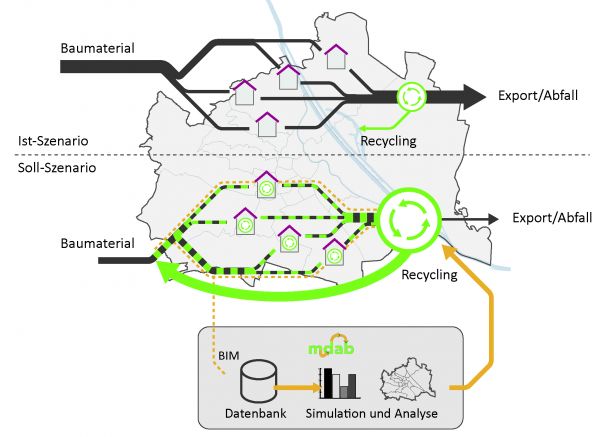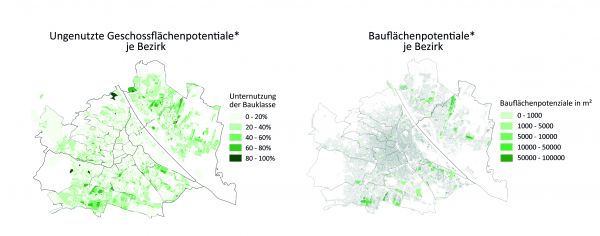M-DAB - Digitise, analyse and sustainably manage the city's material resources
Short Description
Status
completed
Abstract
The Austrian metropolitan region of Vienna is growing. The increasing population leads to as well increasing demands for sustainable, affordable and high-quality housing as new key issues for the government and administration. Used building materials and typical construction methods shape the building fabric of certain construction phase of urban development and therefore define the waste or resources of the future. Moreover, the City of Vienna has set a goal to reuse or recover 80% of construction materials from torn down buildings and major renovation works by 2050 (Smart City Strategy). Actually, waste from the building industry represents about 73% (approx. 48 million tons) of Austria's annual total waste generation (BMK, 2020, p8). In addition to obvious environmental interests, the implementation of applicable processes for the reuse of these resources is also important in an economic sense. The knowledge about quantities and qualities of these bound resources or waste materials is, however, insufficient. In this sense, during this project a set of methods to better digitize, analyse and sustainably manage the city's material resources was elaborated.
The M-DAB research project investigates how digital technologies can support a qualitative (building materials and their recycling) and quantitative (quantities of building materials) determination of existing and future material resources in the construction industry. The key issue in the project will be addressed on three levels, with impacts in different time frames:
- The development of a simulation and visualization tool enables different users in the building industry and administration to access information on hidden material resources in the building stock already on a short term basis.
- The simulation/projection of the availability of construction waste and its recycling potential provides a data basis for the production of secondary building materials for middle and long-term future.
- Identifying, developing or defining the requirements for the openBIM interface by studying processes and defining recommendations for definite action will improve the availability of data in the long term.
In the project the activities are divided into five main contents, which include the analysis of the building stock (1), the development of scenarios and questions (2), the construction of a simulation model (3), the analysis of BIM data and interfaces (4) and the analysis of construction and planning processes (5).
In the data basis for the simulation model, Open Government Data (OGD) with various discipline-specific datasets from different municipal departments of Vienna are merged in a database and further processed in order to obtain the best possible overview (building age, renovation status, areas, volumes, monument protection, dedication, etc.) of Vienna's buildings. In addition, the building data (building document) of hundreds of buildings of a representative sample are being analysed regarding construction methods and materials used and a categorization of the Viennese building stock is conducted. For these categories, key figures for the specific material composition in the categories of use and age are identified and material balances created from selected case studies.
In the simulation and visualization tool, the stock as well as changes concerning quantities of different materials or material groups can be displayed on the basis of the basic data. The spatial resolution of the representation reaches down to building block level. The implementation is a web-based proof-of-concept prototype. The functions and relevant research questions implemented for the simulation were developed using scenario techniques and discussed in workshops with the city administration and representatives of the construction and waste management industries. In addition, existing BIM interfaces and standards were analysed on the base of concrete case studies and compared with the identified requirements from the analysis of construction and planning processes. Based on these findings and in further exchange with stakeholders from the planning and construction industry as well as from the administration (in workshops and numerous expert discussions), recommendations for action and process designs for the continuous improvement of the data situation (with the help of BIM) were defined and elaborated.
Through the project, the knowledge about material resources was improved and a proof-of-concept implementation of a visualization prototype for the spatial location of material resources in the city of Vienna was realized. Over a visual illustration of the automated calculation and simulation results, the tool can serve as a basis for communication and decision-making. During the development of the tool, scenarios were elaborated, which can be configured, simulated and displayed with the visualization prototype. This allows a playful exploration and simulation ("what-if") of different material mixes in new construction, of different policies on building demolitions, as well as the impact of different manifestations of urban growth and spatial requirements. The tool development was accompanied by investigations and identification of requirements for data interfaces and (regulatory) processes in order to make data generation (to improve the present data availability) efficient and economical on the one hand and, on the other hand, to enable data application to a contribution to a sustainable urban development by an early identification of material resources and (recycling) potentials.
The automation and standardization of the data basis is essential for the long-term optimization and permanent monitoring of the construction waste management within the city. The "central" linking and provision of feature data with the geometry information of the building stock depicts a key role for numerous other research and application fields. In the future, the project consortium will deal in depth with the qualification and quantification of potentials for inward development of settlements. For the first time, the material intensity of inward development (resulting material effort) will be made tangible for different development paths, both from a developer's point of view and from the perspective of a city as a whole. The database created in M-DAB and the application of material and environment-related indicators will be used to create a set of methods for the holistic evaluation of areas with high potential and different development alternatives as well as scenarios for resource-saving inward development. The reduction of the use of primary resources and landfill volumes can be made visible at an early (strategic) planning stage.
Project Images
Terms of use: The pictures listed underneath the header “Project Pictures” originate from the projects in the frame of the programmes City of Tomorrow, Building of Tomorrow and the IEA Research Cooperation. They may be used credited for non-commercial purposes under the Creative Commons License Attribution-NonCommercial (CC BY-NC).
Project Partners
Project Management
TU Wien, Institut für Raumplanung, Forschungsbereich Örtliche Raumplanung - DI Dr. Julia Forster
Project- or cooperation partners
- TU Wien, Institut für Wassergüte, Ressourcenmanagement und Abfallwirtschaft, Forschungsbereich Ressourcenmanagement und Abfallwirtschaft: Associate Prof. Dipl.-Ing. Dr.techn. Johann Fellner
- TU Wien, Institut für Architekturwissenschaften, Forschungsbereich Digitale Architektur und Raumplanung: Privatdoz. Dipl.-Ing. Dr.techn. Gabriel Wurzer
- SIDE - Studio for Information Design, DI Erich Kotroczo
- DI Dr. Mathias Mitteregger
Contact Address
DI Dr. Julia Forster
Tel.: +43 (1) 58801 280431
E-Mail: julia.forster@tuwien.ac.at
Web: https://simlab.tuwien.ac.at/




